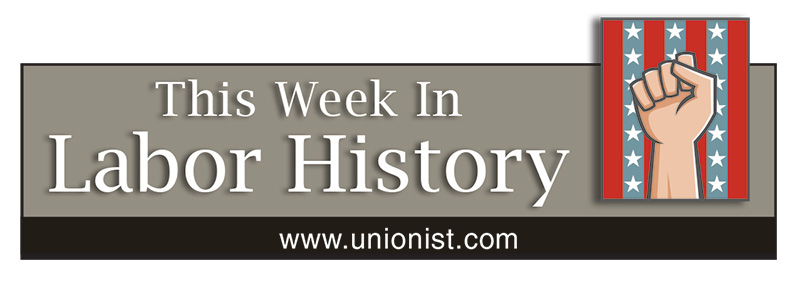
NOVEMBER 23
1170 B.C. – History’s first recorded (on papyrus) strike, by Egyptians working on public works projects for King Ramses III in the Valley of the Kings. They were protesting having gone 20 days without pay — portions of grain — and put down their tools. Exact date estimated, described as within “the sixth month of the 29th year” of Ramses’ reign — 1170 B.C. — in The Spirit of Ancient Egypt, by Ana Ruiz. Scholar John Romer adds in Ancient Lives: The Story of the Pharaoh’s Tombmakers that the strike so terrified the authorities they gave in and raised wages. Romer believes it happened a few years later, on Nov. 14, 1152 B.C.
1903 – Troops are dispatched to Cripple Creek, Colo., to control protests by striking coal miners.
1935 – Mine Workers President John L. Lewis walks away from the American Federation of Labor to lead the newly formed Committee for Industrial Organization. The CIO and the unions created under its banner organized six million industrial workers over the following decade.
1956 – The first meeting between members of the newly formed National Football League Players Association and team owners takes place in New York. Union founders included Frank Gifford, Norm Van Brocklin, Don Shula and Kyle Rote. They were asking for a minimum $5,000 salary, a requirement that their teams pay for their equipment, and a provision for the continued payment of salary to injured players. The players’ initial demands were ignored.
NOVEMBER 24
1875 – Led by Samuel Gompers, who would later found the American Federation of Labor, Cigarmakers’ Int’l Union Local 144 is chartered in New York City.
NOVEMBER 25
1883 – Some 10,000 New Orleans workers, Black and white, participate in a solidarity parade of unions comprising the Central Trades and Labor Assembly. The parade was so successful it was repeated the following two years.
1946 – Teachers strike in St. Paul, Minn., the first organized walkout by teachers in the country. The month-long “strike for better schools” involving some 1,100 teachers — and principals — led to a number of reforms in the way schools were administered and operated.
1947 – Nearly 1,550 typesetters begin what is to become a victorious 22-month strike against Chicago newspapers.
1952 – George Meany becomes president of the American Federation of Labor following the death four days earlier of William Green.
1983 – Canadian postal workers, protesting a Post Office decision to offer discounts to businesses but not individuals, announce that for one week they will unilaterally reduce postage costs by about two-thirds. Declared the Canadian Union of Postal Workers: “(M)embers of the general public, not businesses, can mail letters with 10 cents postage and postal workers will process them without taxing them for insufficient postage.”
NOVEMBER 26
1910 – Six young women burn to death and 19 more die when they leap from the fourth-story windows of a blazing factory in Newark, N.J. The floors and stairs were wooden; the only door through which the women could flee was locked.
NOVEMBER 27
1936 – Some 1,200 workers sit down at Midland Steel, forcing recognition of the United Auto Workers, Detroit.
1937 – The pro-Labor musical revue, “Pins & Needles,” opens on Broadway with a cast of Int’l Ladies Garment Workers Union members. The show ran on Friday and Saturday nights only, because of the cast’s regular jobs. It ran for 1,108 performances before closing.
NOVEMBER 28
1828 – William Sylvis, founder of the National Labor Union, born.
1891 – National Brotherhood of Electrical Workers, precursor to IBEW, founded.
1908 – A total of 154 men die in a coal mine explosion at Marianna, Pa. Engineer and General Superintendent A.C. Beeson tells the local newspaper he had been in the mine a few minutes before the blast and had found it to be in perfect condition.
1953 – Some 400 New York City photoengravers working for the city’s newspapers, supported by 20,000 other newspaper unionists, begin what is to become an 11-day strike, shutting down the papers.
NOVEMBER 29
1934 – Clerks, teamsters and building service workers at Boston Stores in Milwaukee strike at the beginning of the Christmas rush. The strike won widespread support — at one point 10,000 pickets jammed the sidewalks around the main store — but ultimately was lost. Workers returned to the job in mid-January with a small pay raise and no union recognition.
1966 – The S.S. Daniel J. Morrell, a 603-foot freighter, breaks in two during a strong storm on Lake Huron. Twenty-eight of its 29 crewmen died; survivor Dennis Hale was found the next day, near frozen and floating in a life raft with the bodies of three of his crewmates. He had survived for nearly 40 hours in frigid temperatures wearing only a pair of boxer shorts, a lifejacket, and a pea coat.
1999 – National Labor Relations Board rules that medical interns can unionize and negotiate wages and hours.
(Compiled by David Prosten, founder of Union Communication Services)

